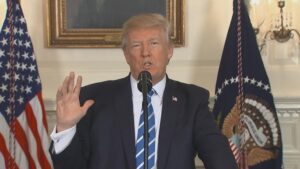President Donald Trump's recent tariff initiative is encountering opposition from Democratic attorneys general, yet historical context and initial economic trends indicate potential benefits for U.S. industries.
Trump's Tariff Program Faces Legal Hurdles Amidst Promising Economic Signs

Trump's Tariff Program Faces Legal Hurdles Amidst Promising Economic Signs
Legal challenges arise from Democratic states as Trump's new tariffs aim to shift trade dynamics for American workers.
The legal landscape surrounding President Donald Trump's tariff program has intensified as several Democratic state attorneys general have filed lawsuits challenging the constitutional authority of the administration's bold new measures. This coalition argues that the imposition of extensive import duties lacks direct congressional sanction and exceeds executive power.
However, the Trump administration's legal team counters this narrative, citing previous legislations such as the Trade Expansion Act of 1962 and the International Emergency Economic Powers Act, which empower the executive branch to act decisively in matters of national economic security. This foundational legal backing asserts that the administration's tariff actions are both justified and necessary.
Critics of tariffs often label them as a gamble that could backfire economically. Yet, historical precedence suggests otherwise. The U.S. has historically relied on tariffs to foster its growing industries, especially during the 19th century when they were the primary source of federal revenue. Figures like Abraham Lincoln and Theodore Roosevelt championed tariffs as a way to bolster domestic manufacturing and protect American jobs from foreign competition.
In contemporary times, targeted tariffs, particularly on key industries such as steel and aluminum during Trump's first term, are credited with revitalizing American manufacturing and job growth. The ramifications of Trump’s fresh initiative, dubbed the “Liberation Day Tariffs,” are already becoming evident; various companies are contemplating relocating manufacturing back to U.S. soil to circumvent impending import costs.
The overarching strategy of the Trump administration is centered around establishing fairness in global trade. The president argues that while free trade should be honored, it must be equitable. For years, nations, including China and other trading partners, have engaged in practices detrimental to the U.S. economy by manipulating trade standards and flooding the market with inexpensive goods. The current tariffs are intended to recalibrate this imbalance, exerting pressure on these countries to make concessions in trade discussions.
Notably, the Trump administration reports that engagement with over 130 countries to negotiate tariff reductions has surged in response to the newly implemented tariffs. This suggests a significant shift in the global trade discourse, where pressure applied through tariffs is prompting faster and more tangible results than traditional negotiation methods.
As the lawsuits brought forth by Democratic-led states navigate the judicial system, the broader implications of Trump's tariff strategy remain deeply entrenched in American economic history and ideology. Rather than a hasty proposal, this initiative reflects a return to robust, historically informed policies aimed at reclaiming America's manufacturing prowess on the world stage.
With the reopening of factories and a notable readiness among global partners to reconsider existing trade agreements, early indicators affirm that the administration's tariffs may indeed be yielding positive changes in the national economy.
However, the Trump administration's legal team counters this narrative, citing previous legislations such as the Trade Expansion Act of 1962 and the International Emergency Economic Powers Act, which empower the executive branch to act decisively in matters of national economic security. This foundational legal backing asserts that the administration's tariff actions are both justified and necessary.
Critics of tariffs often label them as a gamble that could backfire economically. Yet, historical precedence suggests otherwise. The U.S. has historically relied on tariffs to foster its growing industries, especially during the 19th century when they were the primary source of federal revenue. Figures like Abraham Lincoln and Theodore Roosevelt championed tariffs as a way to bolster domestic manufacturing and protect American jobs from foreign competition.
In contemporary times, targeted tariffs, particularly on key industries such as steel and aluminum during Trump's first term, are credited with revitalizing American manufacturing and job growth. The ramifications of Trump’s fresh initiative, dubbed the “Liberation Day Tariffs,” are already becoming evident; various companies are contemplating relocating manufacturing back to U.S. soil to circumvent impending import costs.
The overarching strategy of the Trump administration is centered around establishing fairness in global trade. The president argues that while free trade should be honored, it must be equitable. For years, nations, including China and other trading partners, have engaged in practices detrimental to the U.S. economy by manipulating trade standards and flooding the market with inexpensive goods. The current tariffs are intended to recalibrate this imbalance, exerting pressure on these countries to make concessions in trade discussions.
Notably, the Trump administration reports that engagement with over 130 countries to negotiate tariff reductions has surged in response to the newly implemented tariffs. This suggests a significant shift in the global trade discourse, where pressure applied through tariffs is prompting faster and more tangible results than traditional negotiation methods.
As the lawsuits brought forth by Democratic-led states navigate the judicial system, the broader implications of Trump's tariff strategy remain deeply entrenched in American economic history and ideology. Rather than a hasty proposal, this initiative reflects a return to robust, historically informed policies aimed at reclaiming America's manufacturing prowess on the world stage.
With the reopening of factories and a notable readiness among global partners to reconsider existing trade agreements, early indicators affirm that the administration's tariffs may indeed be yielding positive changes in the national economy.




















